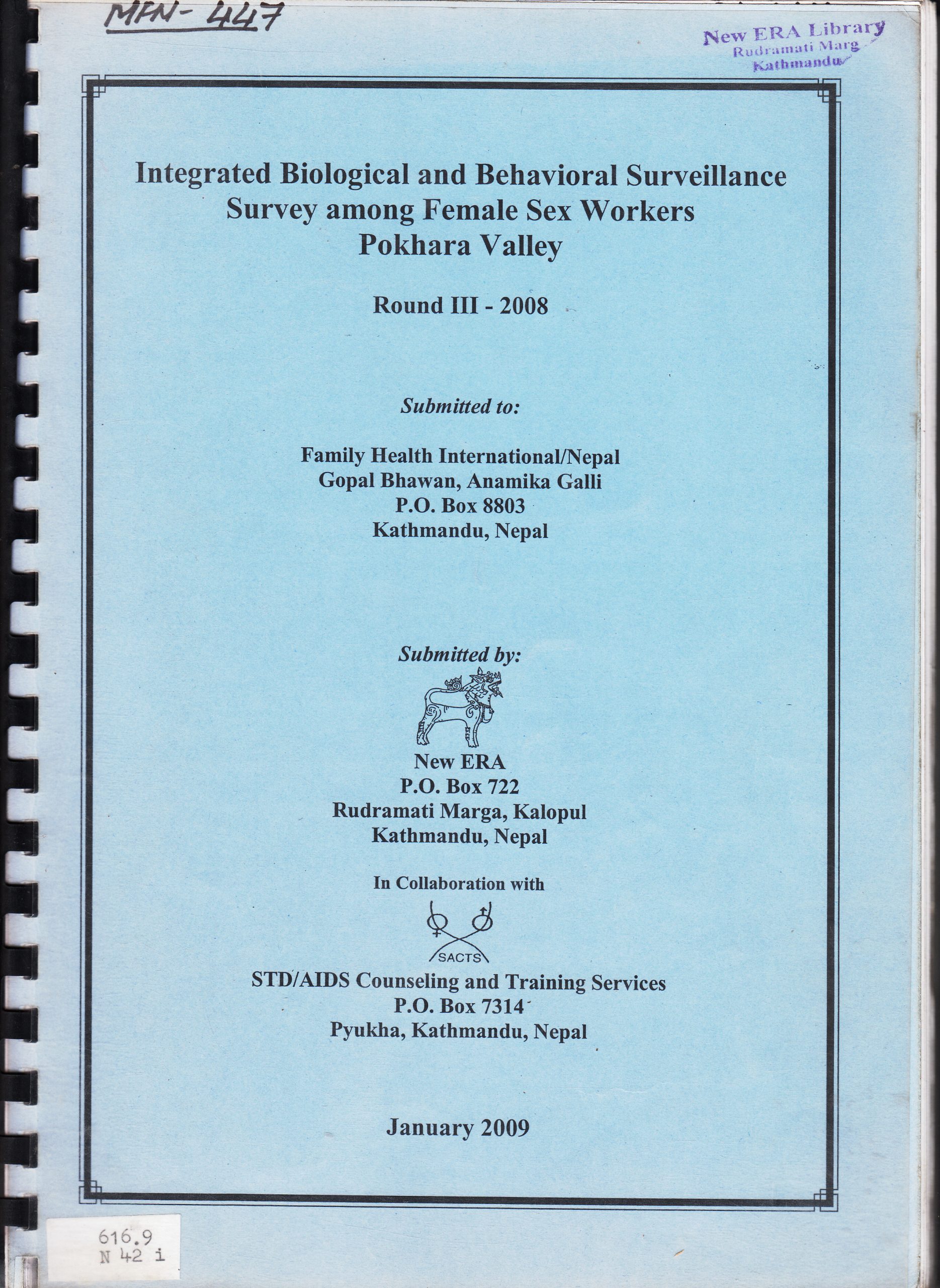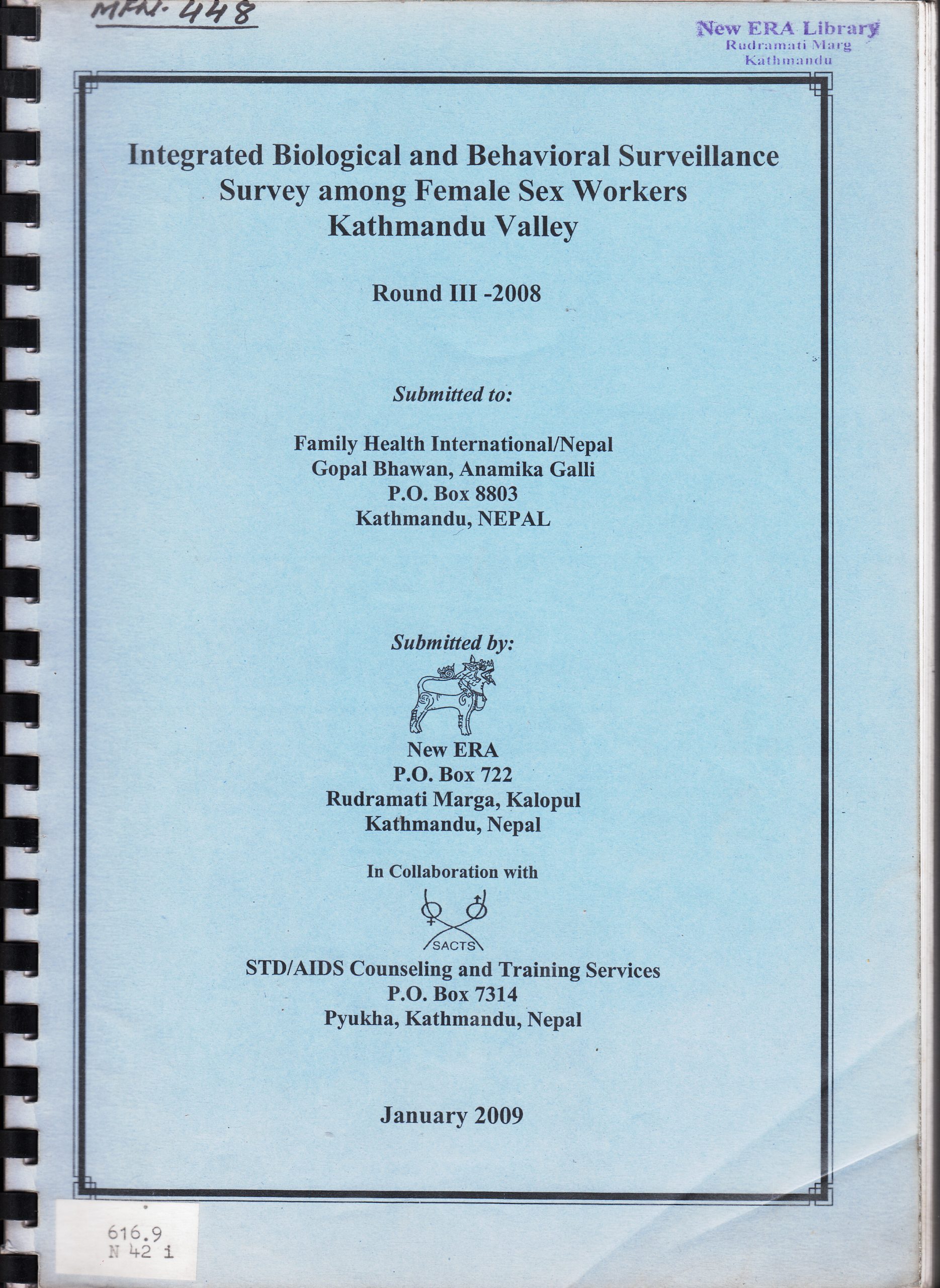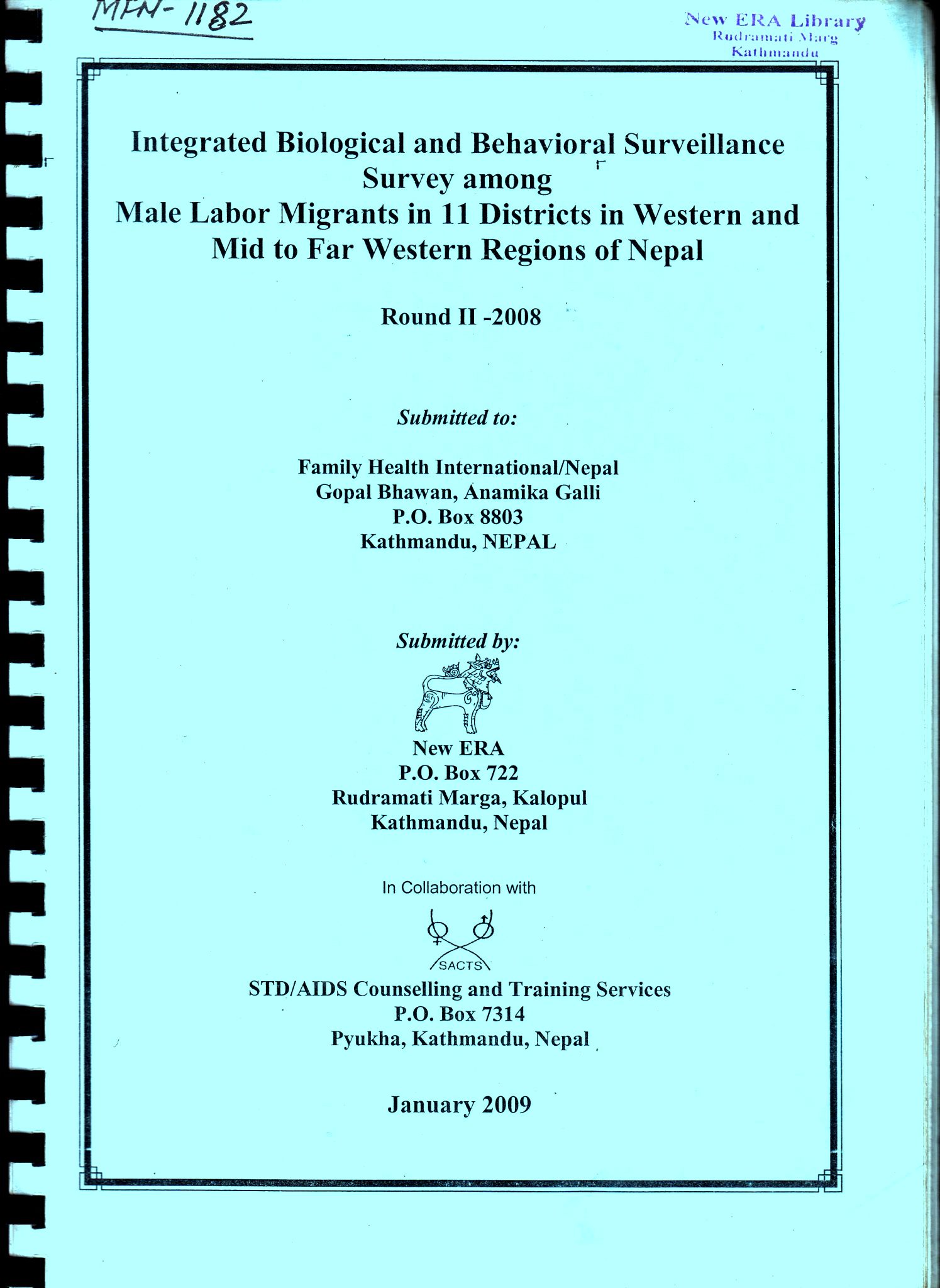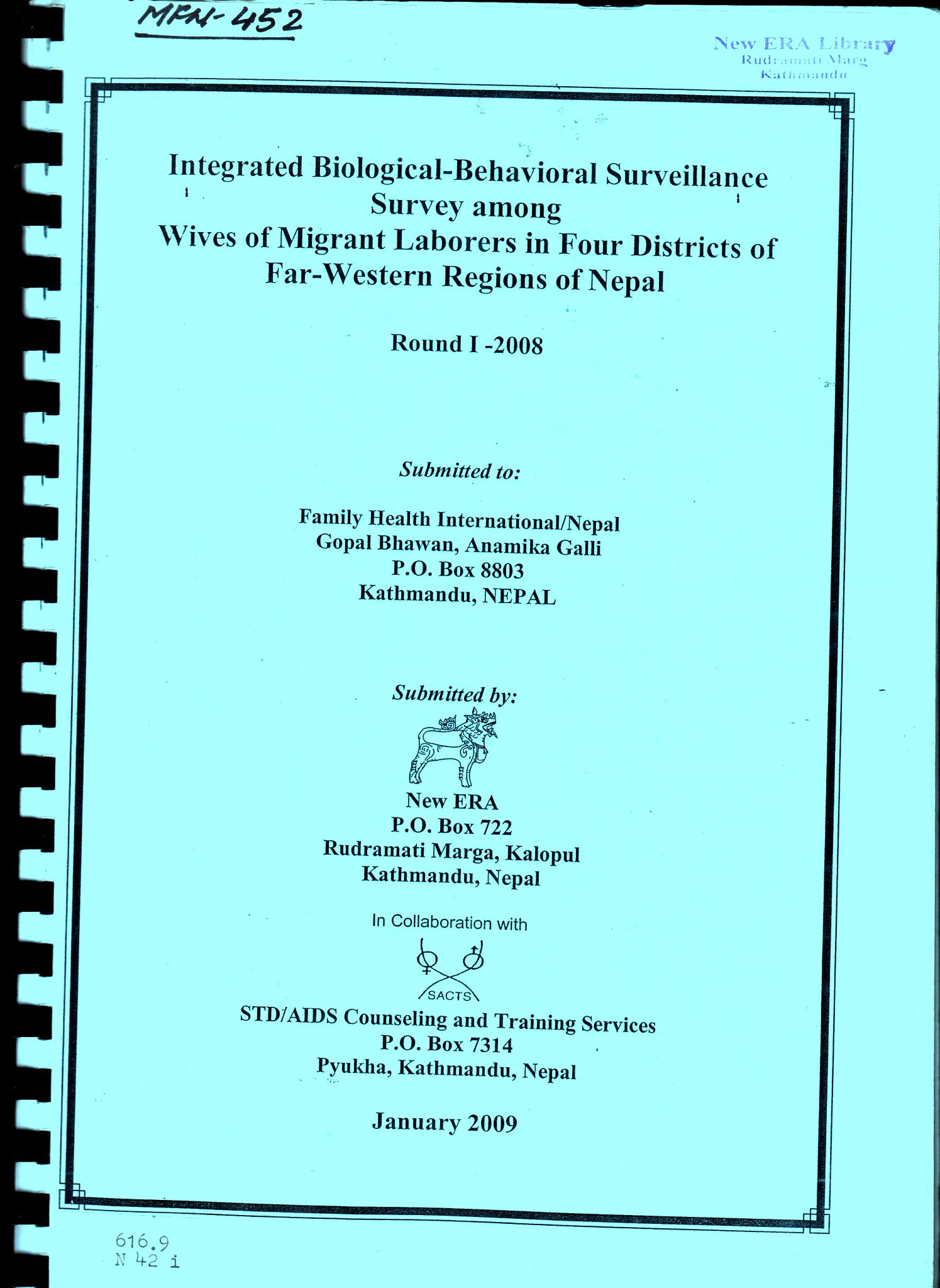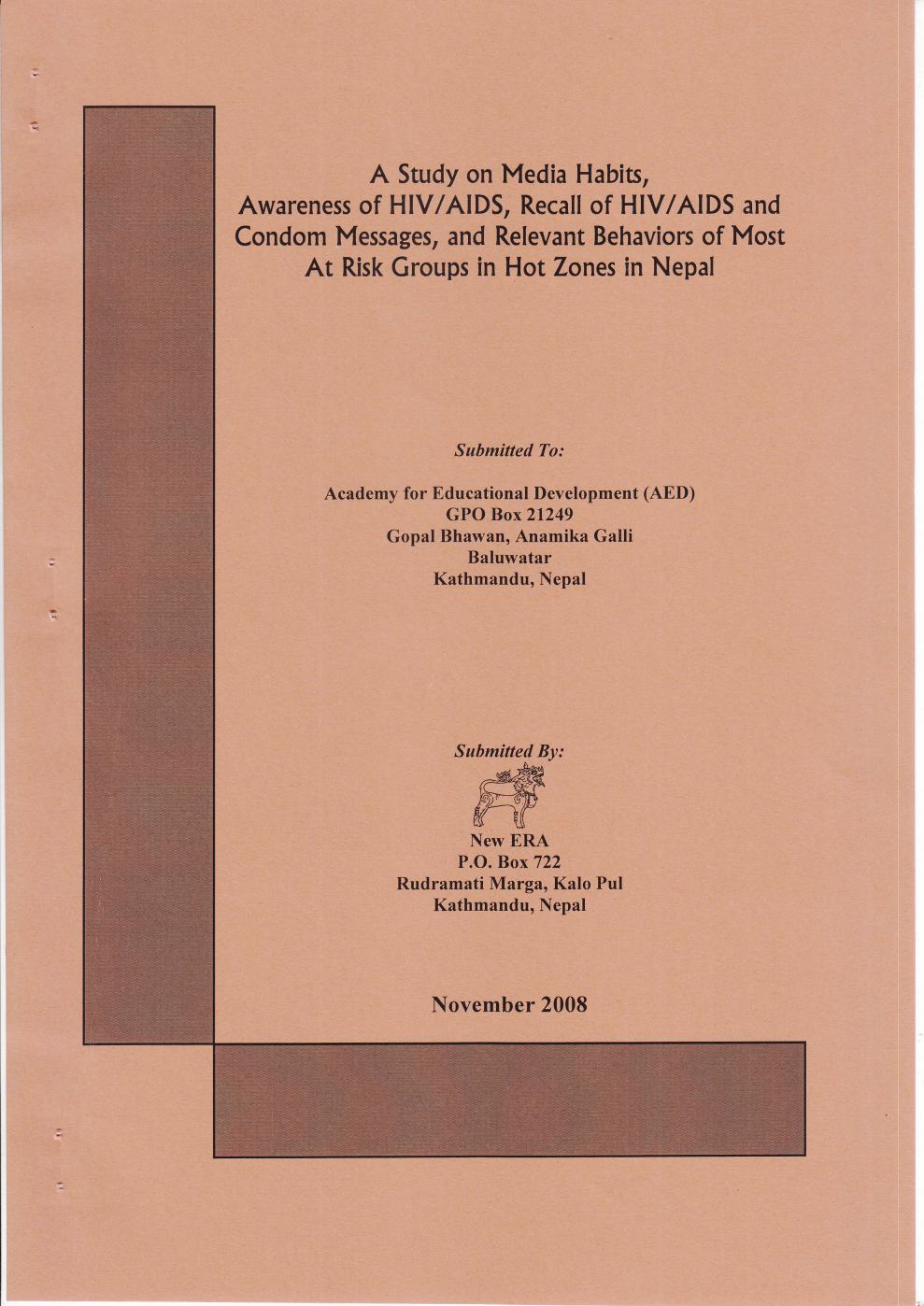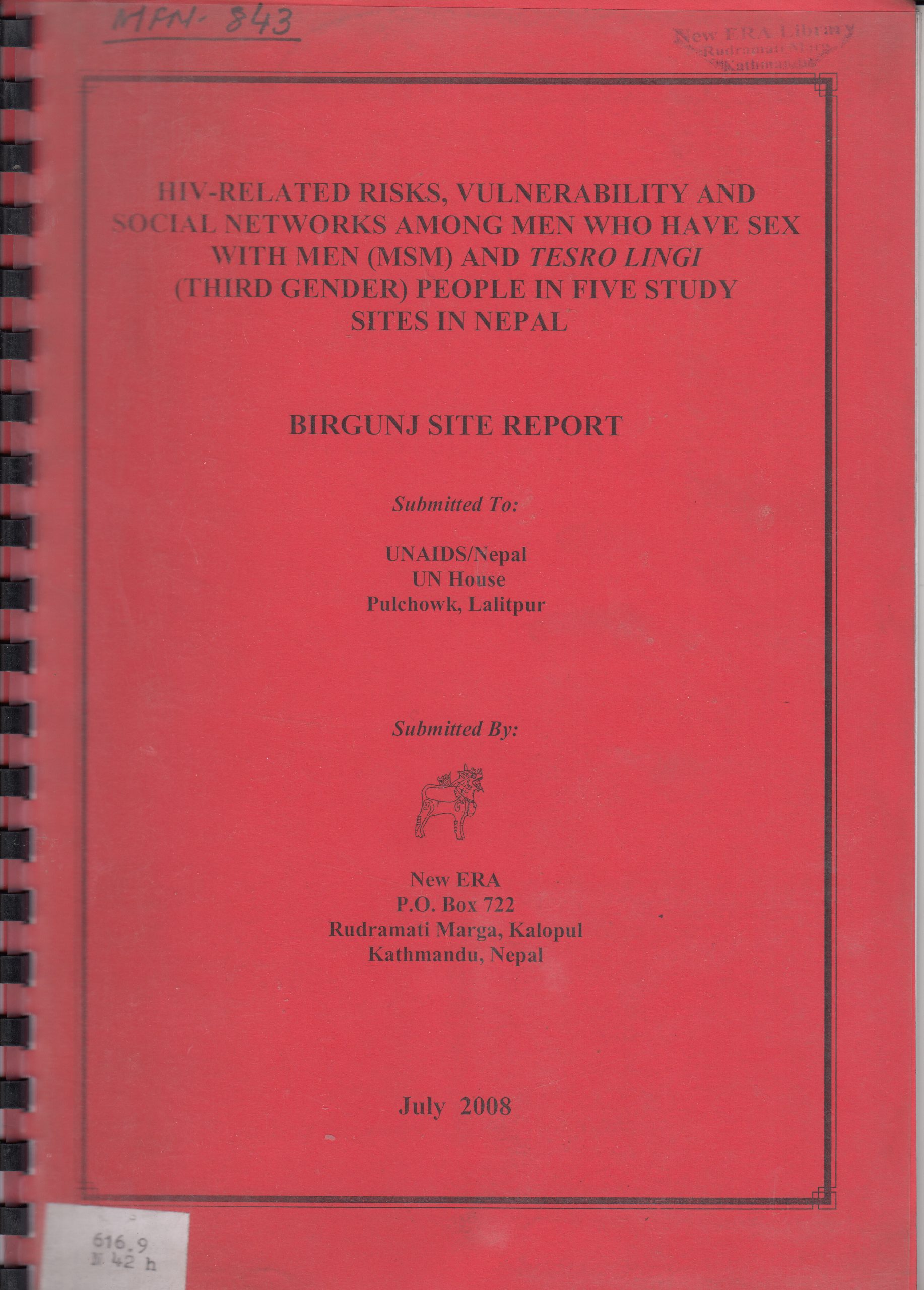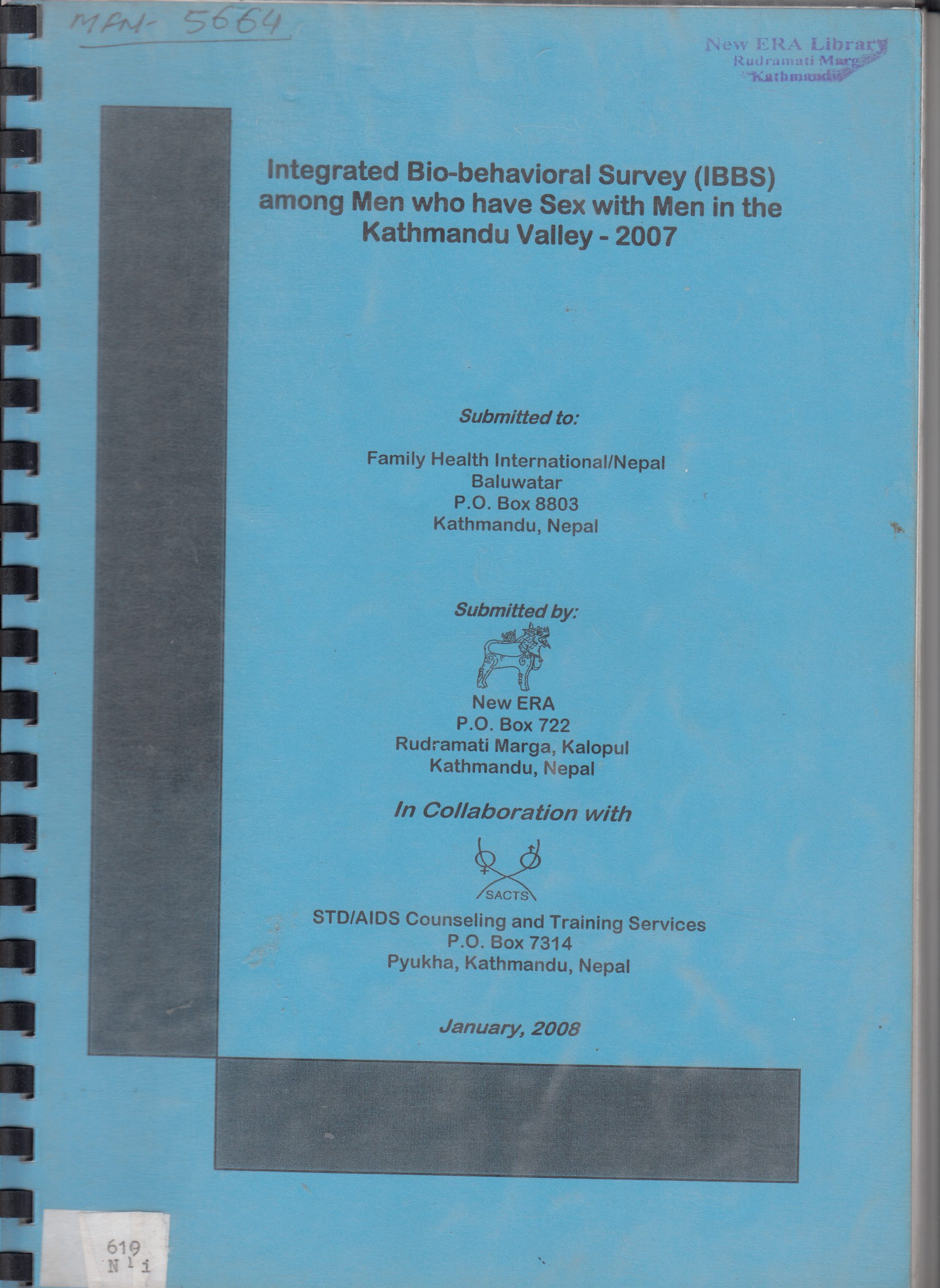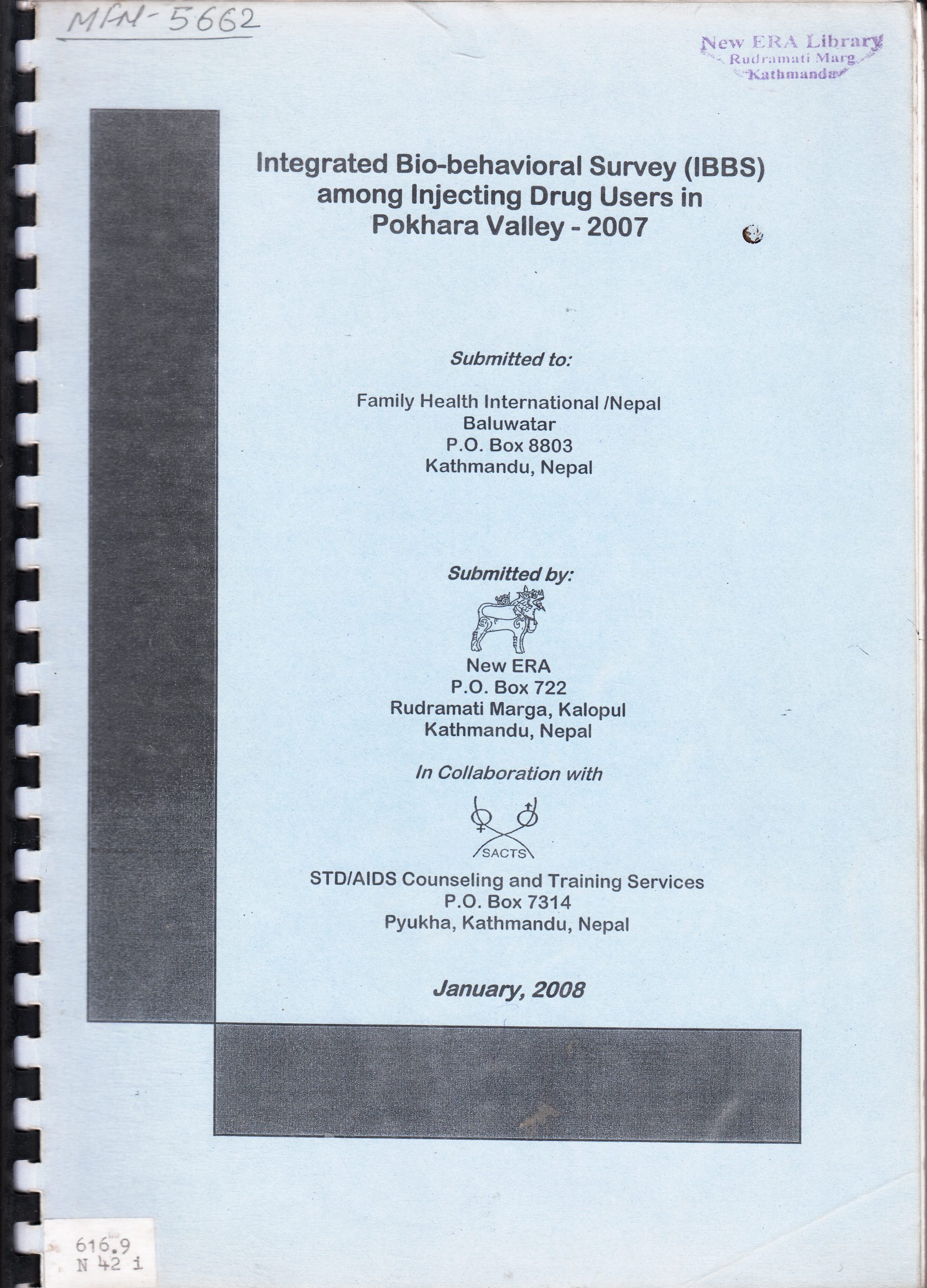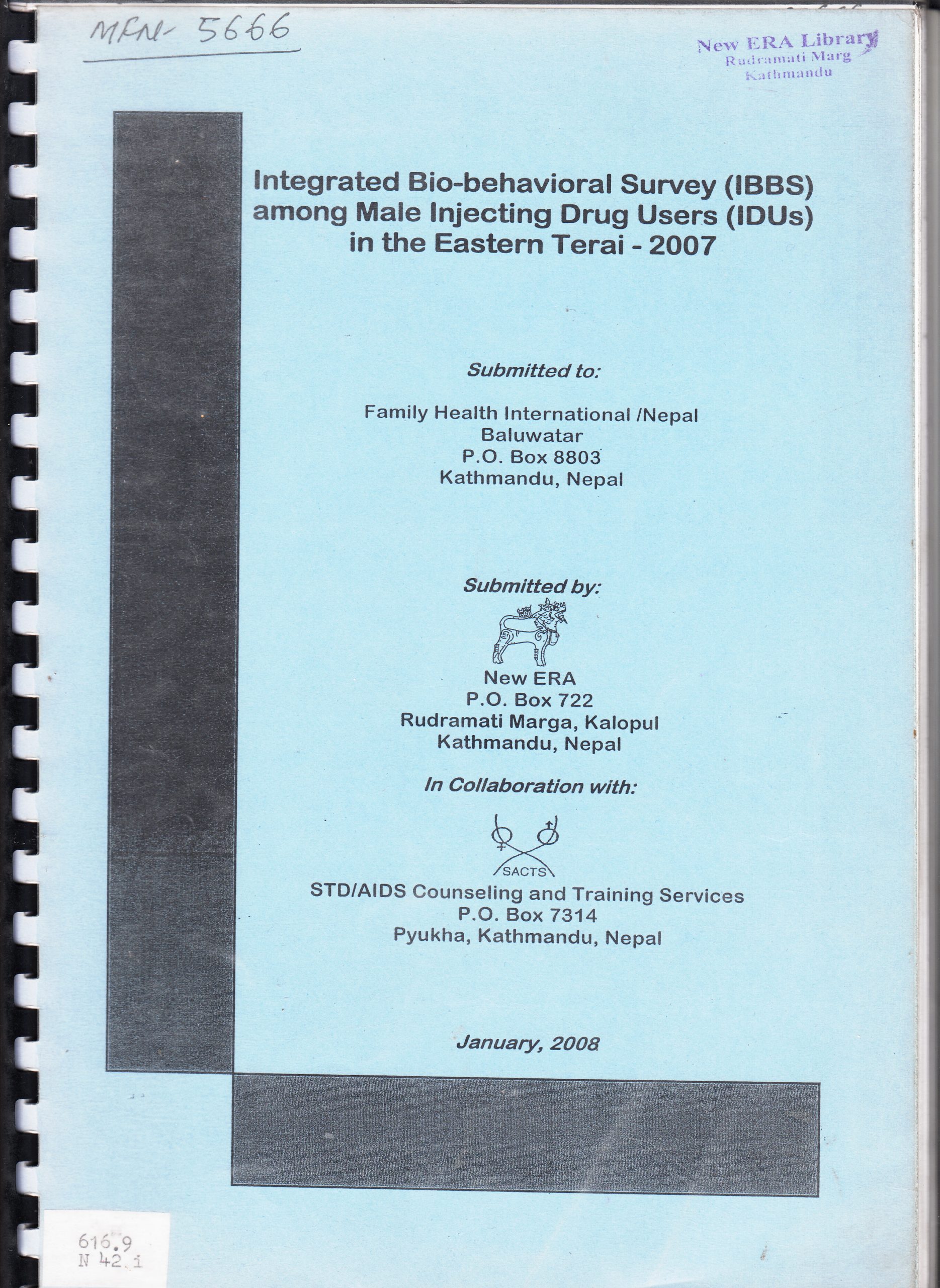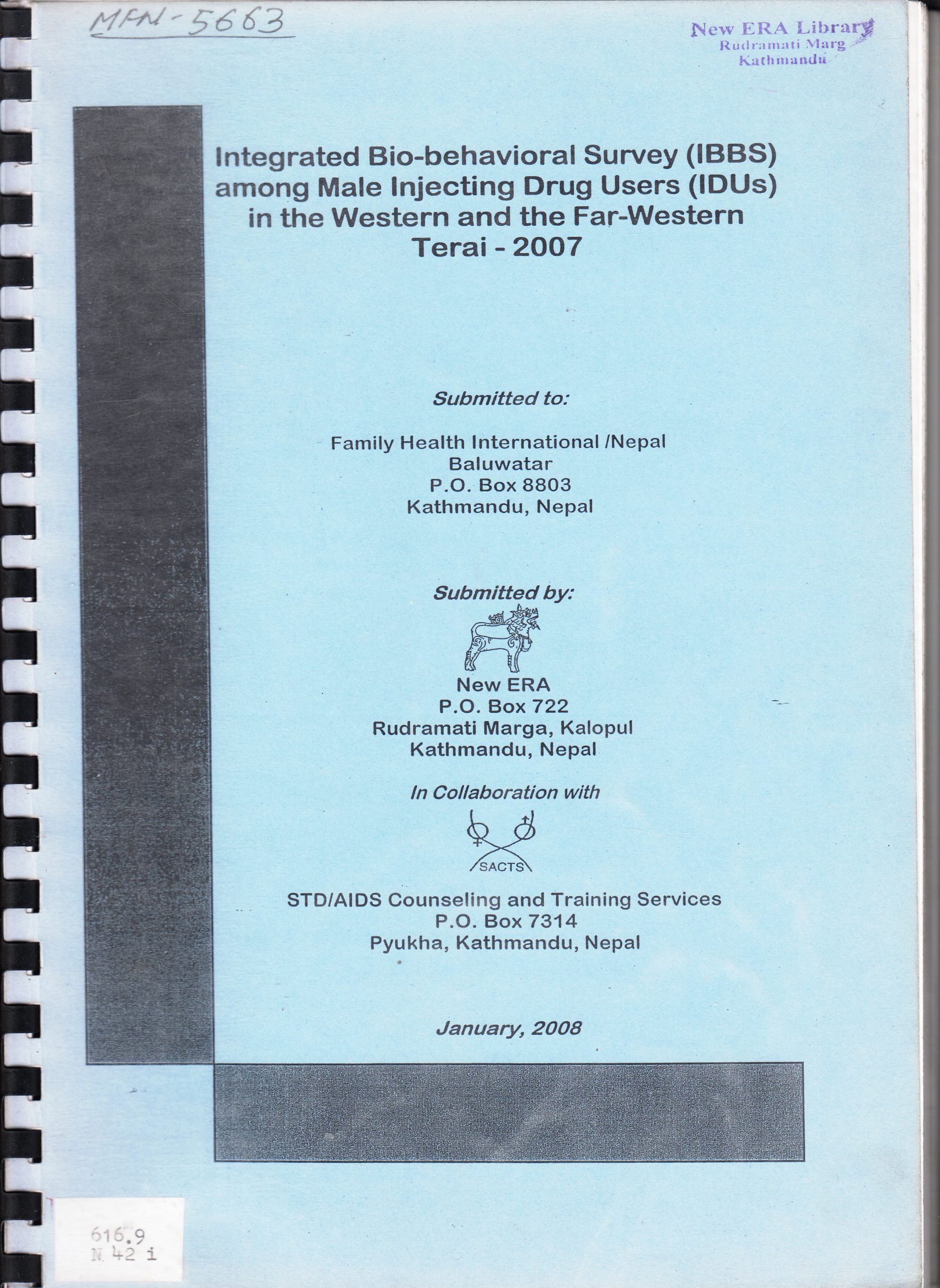This is the third round of IBBS among the Female Sex Workers (FSWs) in the Pokhara Valley. The survey was conducted as per the Second Generation Surveillance Plan of the National Center for AIDS and STD Control (NCASC) for generating strategic information needed to monitor the HIV epidemic in Nepal. The survey was to determine the prevalence of HIV and syphilis and associated risk and prevention behaviors among the study population. The study collected the information on demographic and sexual behavior through a structured questionnaire, while the prevalence of HIV and syphilis through clinical test of blood sample. The study also assesses socio-demographic characteristics; drug using behaviors, knowledge of HIV/AIDS, treatment for STI symptoms, use of condoms, and awareness of HIV/STI services.
Report Type: HIV/AIDS
Integrated Biological and Behavioral Surveillance Survey among Female Sex Workers in Kathmandu Valley, Round III – 2008
This third round of the Integrated Biological Behavioral Surveillance Survey (IBBS) among the Female Sex Workers (FSWs) in the Kathmandu Valley was conducted as per the Second Generation Surveillance Plan of the National Center for AIDS and STD Control (NCASC) for generating strategic information needed to monitor the HIV epidemic in Nepal. The overall objective of the survey was to determine the prevalence of HIV and syphilis and associated risk and prevention behaviors among the study population. The study collected the information on demographic and sexual behavior through a structured questionnaire, while the prevalence of HIV and syphilis were clinical test of blood sample.
Integrated Biological Behavioral Surveillance Survey among Male Labor Migrants in 11 Districts in Western and Mid to Far Western Regions of Nepal, Round II – 2008
This second round of the IBBS among male labour migrants of Western to Far Western Regions of Nepal was conducted as per the Second Generation Surveillance Plan of NCASC for generating strategic information needed for monitoring the HIV/AIDS program in Nepal. The overall objective of the study was to determine the prevalence of HIV among the 18-49 years aged returnee male labour migrants from India. The study assessed HIV/STI risk related behaviours, socio-demographic characteristics, sexual and drug using behaviours, knowledge and treatment of STI problems and the knowledge, use of condoms and knowledge of HIV/AIDS of returnee male labour migrants.
Integrated Bio-Behavioral Survey among Wives of Migrant Laborers in Four Districts of Far Western Regions of Nepal, Round I – 2008
This is the first round of the Integrated Biological Behavioral Surveillance Survey (IBBS) among the wives of the labour migrants in Far Western Regions of Nepal. The overall objective of the study was to determine the prevalence of HIV among the wives and widows of current or ex-labour migrants to India of aged 16 years and over, whose spouse had spent at least three months in India and who had returned to Nepal at least once in the last three years. The study assesses the risk for HIV infection, condom use, sexual behaviours, knowledge of HIV/AIDS and STI, exposure to HIV/AIDS awareness messages and alcohol/drug use habits study population
A Study on Media Habits, Awareness of HIV/AIDS, Recall of HIV/AIDS and Condom Messages, and Relevant Behaviors of Most At Risk Groups in Hot Zones in Nepal
This study was to explore the media habits, awareness of HIV/AIDS, recall of HIV/AIDS and condom messages, and relevant behaviors of most-at-risk groups in high-risk areas of Nepal. The survey covered five sub-groups of the population considered to be most at risk from HIV infection: a) Female sex workers (FSWs), b) Clients of FSWs, c) Transport workers/truckers, d) Migrant workers and, e) Male and female youths between the ages of 17-24 years. This study has made recommendations in relation to the HIV awareness and condom promotion campaign focusing on the most-at-risk groups.
HIV- Related Risks, Vulnerability and Social Networks among Men who have sex with Men (MSM) and Tesro Lingi (Third Gender) People in Five study Sites in Nepal
This study was carried out in collaboration with the Blue Diamond Society (BDS) and the Federation of Sexual and Gender Minorities (FSGM) Nepal with technical and financial support of UNAIDS, USAID and FHI. The study was to provide information on HIV risk behaviors, vulnerability, social networks among MSM and Tesro Lingi in east to mid-west five urban sites namely Biratnagar, Birgunj, Bhairahawa, Butwal and Nepalgunj. The study assesses the categories of MSM and third gender groups, interactions with other high-risk groups, use of condom, injecting drugs, mobility patterns.
Integrated Bio-Behavioral Survey (IBBS) among Men having Sex with Men (MSM) in Kathmandu Valley – 2007
This is the second round of IBBS among Men Sex Men (MSMs) study in Kathmandu valley. The main objective of this study was to collect strategic information to analyze trends in risk behavior and HIV/STI prevalence rate among MSM working Kathmandu Valley (urban areas of Kathmandu, Bhaktapur and Lalitpur). The study also assesses health risk behaviors of this group. The study is also to analyze trends through comparison with data obtained from the 2006 IBBS in the Valley.
Integrated Bio-Behavioral Survey (IBBS) among Injecting Drug Users (IDUs) in Pokhara Valley – 2007
This study was conducted to determine the prevalence of HIV and Syphilis among IDUs working in the Pokhra valley and to assess their HIV/STI related risk behaviors and to analyze the trends through comparison with the data obtained from the 2006 and 2004 IBBS in the Pokhra valley. It also aimed at collecting information related to socio-demographic characteristics, sexual and drug using behaviors, knowledge of HIV/AIDS, knowledge and treatment of STI problems, knowledge and the use of condoms, and exposure to available HIV/STI services from the FSW’s in Pokhra and to relate them with HIV and Syphilis infection.
Integrated Bio-Behavioral Survey (IBBS) among Injecting Drug Users (IDUs) in Eastern Terai of Nepal – 2007
This is the second round of IBBS in eastern terai (Jhapa, Morang and Sunsari districts) conducted among Injecting Drug Users (IDUs). The main objective of this study was to determine the prevalence of HIV/AIDS and Syphilis among IDUs working in the Eastern terai and to assess their STI, HIV/AIDS related risk behaviors among the IDUs. The study also analyzed the trends through comparison with the data obtained from the 2006 IBBS in the eastern terai. It also assesses socio-demographic characteristics, sexual and drug using behaviors, , knowledge and treatment of STI problems, knowledge and the use of condoms, and exposure to available HIV/STI services knowledge of HIV/AIDS in the IDUs of the region.
Integrated Bio-Behavioral Survey (IBBS) among Injecting Drug Users (IDUs) in Western to Far-western Terai Region of Nepal – 2007
This is the second round of IBBS among Injecting Drug Users (IDUs) in western – far-western terai (Rupandehi – Kanchanpur) of Nepal. The main objective of this study was to determine the prevalence of HIV/AIDS and Syphilis among IDUs working in the study areas. The study also assesses HIV/STI related risk behaviors and analyzed the trends through comparison with the data obtained from the 2006 and 2004 IBBS in the region. The study also assesses socio-demographic characteristics, sexual and drug using behaviors, exposure to available HIV/STI services, knowledge and treatment of STI problems, knowledge and the use of condoms, and knowledge of HIV/AIDS in the IDUs of the region.



